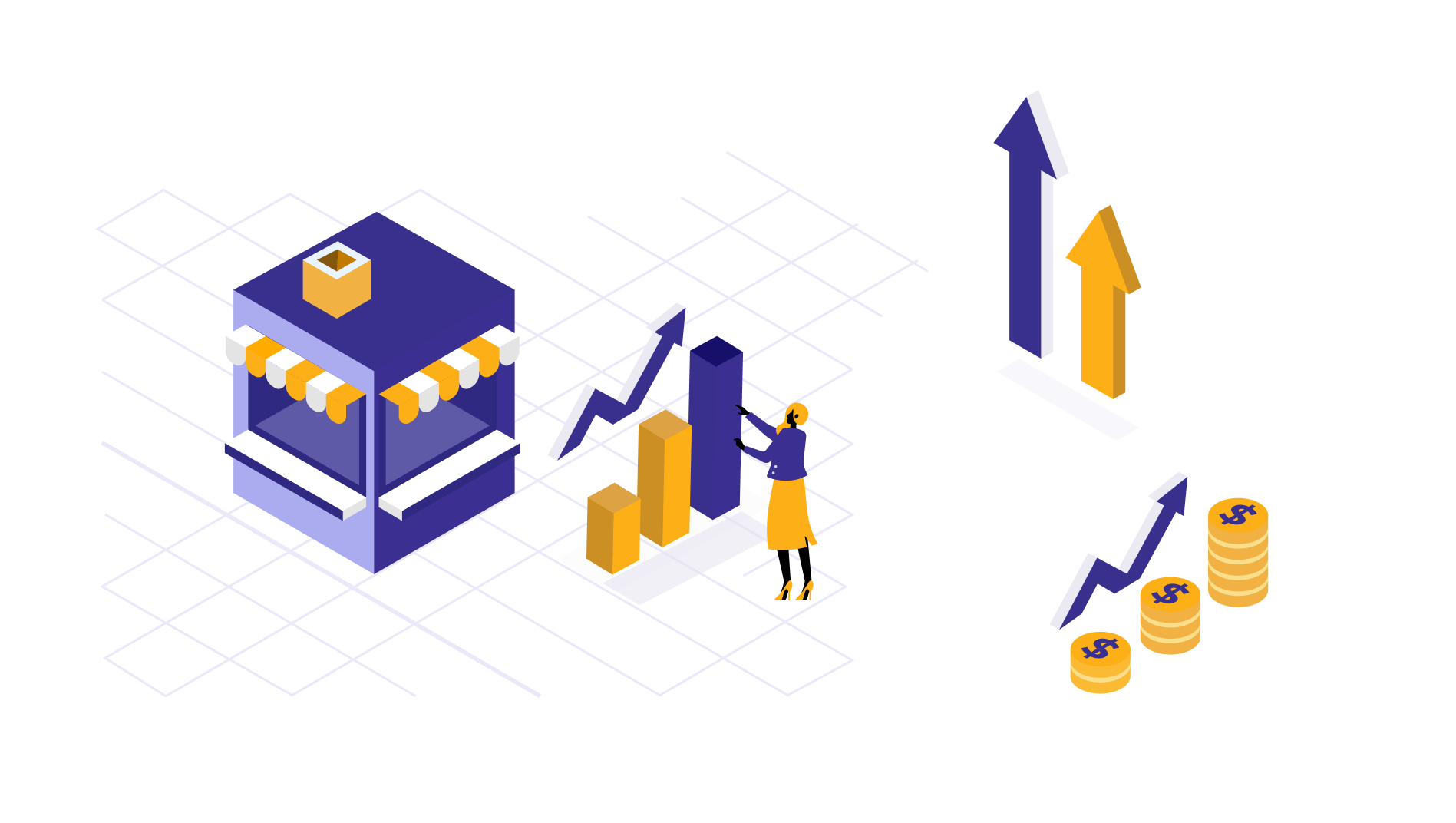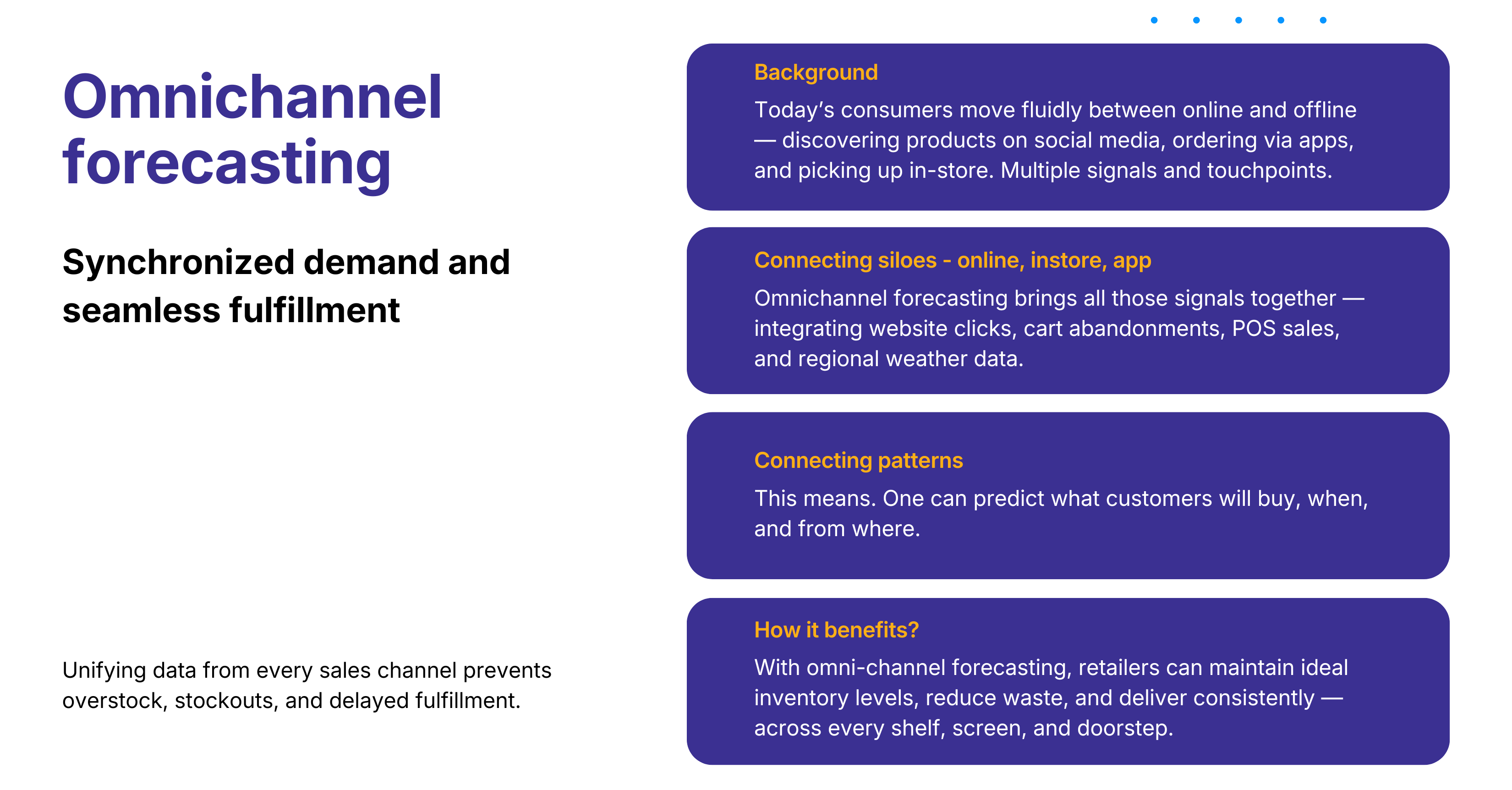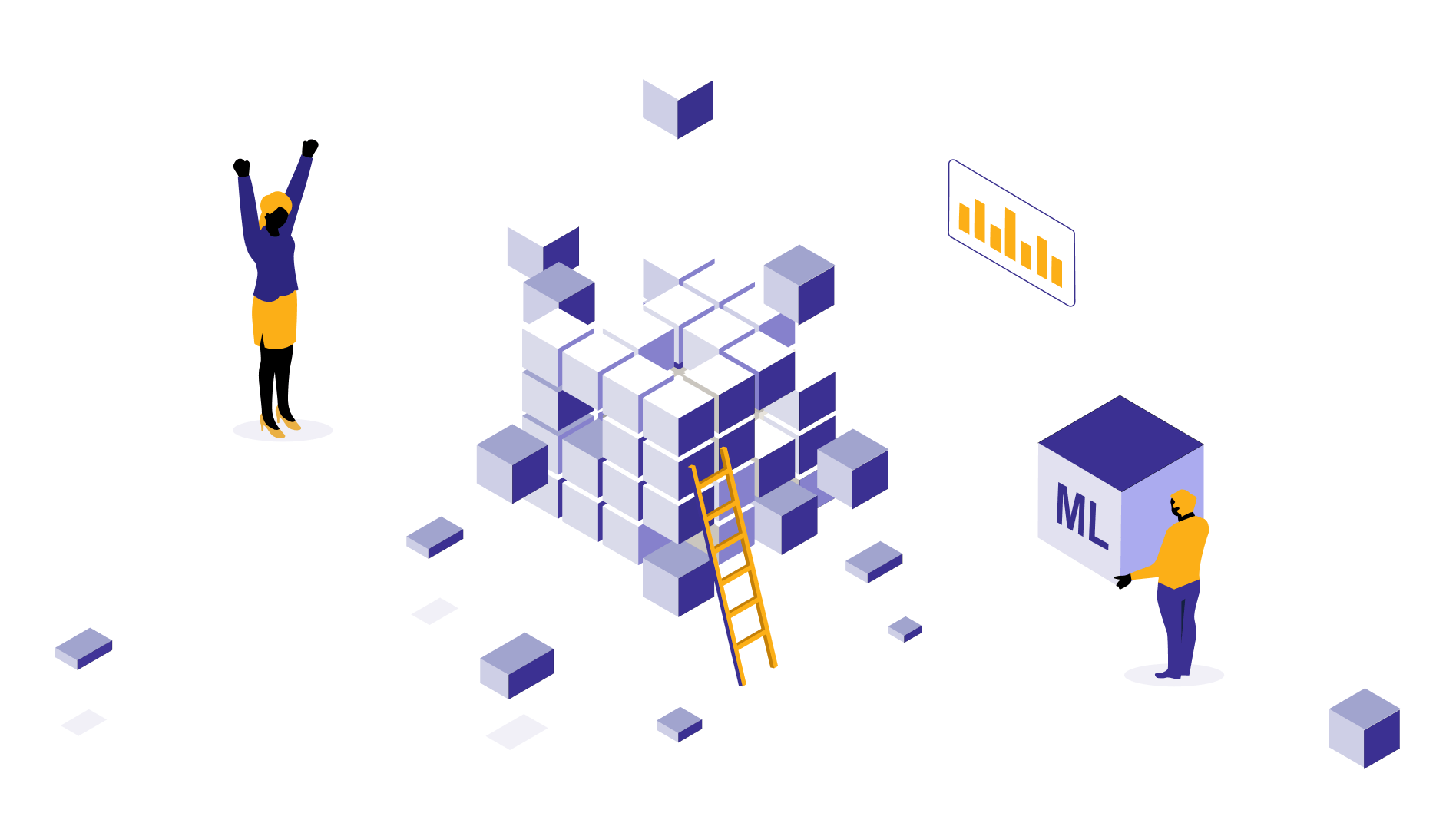Retail demand forecasting
Demand forecasting could change the future of retail companies, foretelling them what their customers might want in the future. Spilling the beans on how you could change yours, demonstrating real-life examples of those who successfully cracked the formula for retail demand forecasting.

Thulasi
July 22, 2024 |
6 mins

What is demand forecasting in retail?
A storefront that’s designed as if the store has read customers’ minds, catering to their changing preferences. That’s what demand planning in retail is all about. Accurate demand prediction -> Optimal inventory -> More sales.
Retail demand forecasting is predicting the number of expected sales of an upcoming period, based on the historical sales data, market trends, economic factors, seasonality, and many other factors. Knowing this ahead, your business can take care of your inventory and prepare marketing and promotional campaigns accordingly. Also, you dodge bullets like out-of-stocks and lost sale opportunities while effortlessly taking advantage of changing trends.
Feeling that this could be complex? This is what Amazon does, predicting their everyday demand, location-wise, category-wise, product-wise, and more. And, they integrate this data with dynamic pricing model, supply-chain, and inventory management to keep their operations running as per the respective period’s demand.
Why is forecasting demand important in retail?
While a retail company could certainly run their operations without forecasting, doing it helps them increase profitability and be more adaptable.
Some benefits you get by incorporating demand forecasting and business intelligence in retail’s day-to-day jobs:
Better customer experience
Have you ever felt the urge to buy a product and bump into a shop that exactly offers it on sale? The satisfaction level can be unmatchable as the customer’s needs are met before they start hunting for it. When customers sense the sync, they will keep coming back for more, bringing you more business, a formula that top retailers like H&M, Walmart, etc. are using.
Make informed decisions
A typical day for a retailer involves multiple decisions to be made regarding inventory handling, marketing, staffing and resources, and many similar categories. An accurate demand forecast report could ease this process, leaving no room for guesswork or wrong steps. Think of the financial damages a business might go through just because they didn’t see something coming. Example: A retail grocery chain piling meat for a holiday season wherein reduce their meat intake because of a poultry disease outspread.
Inventory management
Retailers bump into many unanswered questions when it comes to inventory management. Which product sells well and needs a re-order? And these sales are for what locations, what sizes, and in what numbers. All these questions require considering the near and far future for accurate inventory.
Current sales data will not be enough to make the right decision. That’s where retail demand forecasting can step in.
Eliminate waste
Selling physical goods, wastage is one of the growing concerns retail companies are trying to curb. According to the Food Waste report 2024, retail was responsible for 131 million tonnes of waste out of 1.05 billion tonnes of food waste. It’s not just food, but in some cases medicine, clothing or lifestyle items. Some major factors driving waste include: not moving stocks on time, lack of product discoverability, poor market knowledge, growing preferences for fast fashion, and unplanned production caused by poor demand forecasting in manufacturing. While the modern retail industry is pushing hard toward sustainability and reduced carbon footprints, the issue still persists in different forms. For retailers struggling with discoverability challenges, guides on how to improve online product discovery often go hand-in-hand with inventory optimization, ensuring the right products actually reach the right customers before they turn into waste.
There is a way out though. Using data and analytics to understand demand thoroughly and adopting effective supply chain strategies. This way, retailers won’t bring in more than the required amount of stocks and reduce unsold wastage that ends up in landfills.
Recommended read: What is the meaning of data processing?
Improve cash flow
Keeping a stable and positive cash flow can be challenging when you engage in unplanned purchases and improper inventory stockpiling. Demand forecasting helps you optimize inventory merchandise, so you only buy necessary stocks and not go for unnecessary discounts to sell the excess goods. This not only reduces wastage but improves stock to cash ratio. Also, through reliable projections, you could streamline your marketing campaigns and improve sales. All of which positively impact cash flow.
Other than that, forecasting reduces operational costs. Here is the proof from McKinsey. Their reports state that a strong forecast could reduce warehouse costs by 5 to 10% and administrative costs by 25 to 40%.
Demand forecasting - Factors to consider
Demand forecasting is a continuous process. Hence, you should be fully prepared before you start predicting sales. Use the below pointers as checklists if you are about to begin your retail demand forecasting journey.
Know your needs
Start with investigating your teams on why you need to forecast demands and your expectations for that? What are the goals your team is trying to achieve. Do you need short-term or long-term forecasting? Will that be a micro or macro forecasting? Do you need it for selected products or all products? What demographics must be considered for this? How are you planning to conduct market research and customer demand audit? And the list of questions can go on and on.
Answering these questions is essential as they will guide you on how you use forecasting for your business. And what are the teams that benefit from the inputs and what kind of tracking could you enable to measure the forecasting effectiveness?
Market trends
Market trends vary from time to time. But these trends shape customer buying behavior and decisions. For example, an artist sported in a specific-branded shoe could create a demand for the particular product, brand, or even product color. One real time example would be the Barbie movie and how it led to people purchasing pink color accessories and clothes. This example used to be a universal trend. There are local and zonal market trends, too. Sudden inflation or plummeting GDP could also influence retail market trends. As these factors decide product demand, customer shopping value, and sales, one must account them for during retail forecasting.
Product demand
Out of all the factors related to demand forecasting, product demand is crucial as it’s proportional to sales and revenue. To understand product demand, you need to study your historical sales data and read between its highs and lows. Since demand varies throughout different seasons, it’s good to know the high, low, and mid demand seasons to align product availability and demand forecasting in line with that.
Adding to that, your inventory forecasting should also account for the three stages of the product lifecycle - introduction, growth, maturity, and decline.
Other product demand factors that your forecasting must consider include:
Demand changes across sizes, flavors, and other product variants
New product or range introductions and how that merges with existing product demands - this is crucial to avoid cannibalization effects on old products by the new product.
How seasonality affects your product demand. For example, certain products like festival clothing, decorations, chocolates, etc. sell a lot during holiday seasons.
Keeping in mind all the above factors will ensure that your demand forecasting is accurate, leading to product availability in right quantities throughout.
Buying patterns
Like market trends, consumer behavior and buying patterns are dynamic in nature too. The pattern could change based on customers’ age, background, job, financial status, gender, and many other factors. While it can be hard to conclude each segment's behavior, you could still observe a pattern and how these background factors influence their purchasing behavior. The pattern can be about the number or quantity of products, brands they prefer, buying timings, etc. One basic example for this buying pattern is working people buying weekly vegetables and fruits during every Sunday evening.
Buying patterns could also be about in-depth patterns like impulse buying, wanting to follow trends, budget, channels/places they search when they need something, personal goals and aspirations, and more.
Since modern forecasting systems consider all these external factors, their demand forecasting is more accurate than traditional forecasting.
Pricing
Six out of 10 customers go for lower-priced products for more convenience and high savings. So, when a product is sold at lower prices because of promotional campaigns or by default, it can affect other similar products’ sales too. This is why CPGs and retailers must consider the pricing of the product while projecting demands. Also, new products being launched could receive increased attention, hampering sales of old products.
External factors
While the above ones directly influence retail sales and demand, there are some external factors too, which indirectly influence the purchasing decisions. Some examples could be global pandemic situations, extreme weather, natural calamities, geopolitical movements, competitor moves, etc.. In general, these are things that aren’t in your control.
Examples of how external factors affect sales: heavy snowfalls leading to blocked roads and closed shops, or high temperature leading to increased ice cream and cold drinks sales.
Taking into effect these changing external factors must be a part of the retail demand forecasting. This is why our data scientists include weather data into forecasting models for improved accuracy.

Demand forecasting for omni-channel strategy
Retail industry is expanding their horizons by delivering products through omni-channels. They are omnipresent now and are taking their bricks-and-mortar store to website, app, social media, etc. The flexibility helps them with meeting their customers wherever they are, while increasing their sales opportunities. Most CPGs, grocery chains, and wholesalers these days have mobile apps and websites for online ordering, store pickup, curbside pickups, etc. And, these channels are also driving revenue to the company, just like mortar-and-bricks stores.
In that case, predictive analytics for marketing and in-store sales alone cannot help retail companies. A retail company operating on multiple channels must go for an omni-channel approach that encompasses every medium they sell through.
Let’s assume that a retail company gains 40% of its revenue through online sales. In that case, loading their inventory based on their store sales data could create discrepancies, leading to out-of-stock and lost sales.
Hence, for accurate forecasting and timely fulfillment, omni-channel demand forecasting or time series analysis forecasting is imperative. The results could help retailers have ideally-stocked distribution centers and inventories, ensuring availability across every channel they deliver through.
But it’s rather easier said than done. Combining and co-relating mortar-and-brick sales to other channels is like comparing apples to oranges. External factors, customer behaviors, buying tendencies, and even the marketing campaigns widely vary among the both above-mentioned categories. One good example is how people wishlist or add products to cart to buy later. Or how weather affects people from visiting stores, which might not be a great hindrance to online shopping cases.
It requires more data, clever understanding of demand over different periods, and a more granular forecast report to win beyond these roadblocks.
Leave your demand forecasting worries to us
We have listed down the factors one might consider as they approach demand forecasting for their retail business. However, it’s only the beginning. One of our clients followed that to construct a base forecasting model which predicted with 70% accuracy. But, running in an agile, fast-moving business, the data was not enough for them. They wanted a stable, scalable, and more accurate model that delivers timely forecasts through self-service analytics—something that could grasp market changes and respond accordingly. That’s where our team stepped in. By improving forecasting accuracy, increased sales and revenue, so that they could focus on having the right products in the right place at the right time. No stress of overstock or stock-outs. Talk to our data scientist and see how we could do the same for your business too, retail, eCommerce, or any other industry in general.



